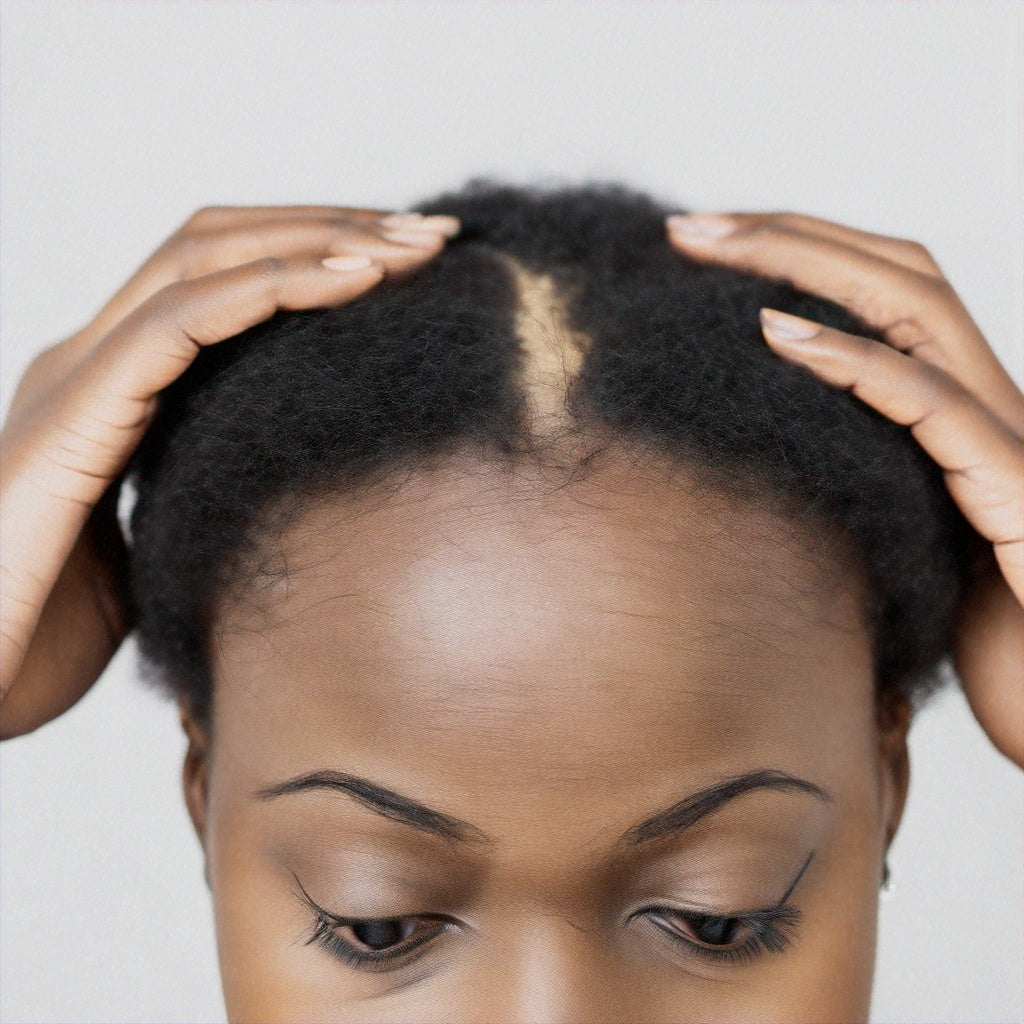

Did you know that up to 50% of Black women experience some form of alopecia during their lifetime?
Living with alopecia while managing textured hair brings unique challenges that standard hair care advice often overlooks. From traction alopecia caused by protective styles to other types of alopecia that affect our beautiful crowns differently, the journey can feel overwhelming.
But here's the empowering truth: with the right knowledge and proper care, you can effectively manage alopecia while nurturing your textured hair. Whether you're dealing with recent hair loss or seeking better treatment options, this comprehensive guide will walk you through everything you need to know about managing alopecia with textured hair.
Ready to take control of your hair health journey? Let's explore the solutions that work specifically for you and your unique hair needs.
Table of Contents
Understanding Alopecia in Textured Hair
When it comes to textured hair, alopecia presents unique challenges that require specialized understanding and care. Your natural hair texture plays a significant role in how different types of alopecia manifest and progress.
How Alopecia Affects Different Hair Types
Your textured hair's natural structure makes it more susceptible to certain types of hair loss. The elliptical shape of your hair follicles, combined with the natural curl pattern, creates distinct patterns of hair loss that may differ from other hair types. When alopecia occurs, you might notice changes in your hair texture, often becoming drier and more brittle, particularly in cases of scarring alopecia.
Common Types of Alopecia in Textured Hair
Understanding the various types of alopecia that commonly affect textured hair is crucial for proper treatment:
Central Centrifugal Cicatricial Alopecia (CCCA): Primarily affects women over 30, causing permanent hair loss around the crown
Traction Alopecia: Develops from tight hairstyles and protective styling
Androgenic Alopecia: Pattern hair loss affecting both men and women
Alopecia Areata: Autoimmune condition causing patchy hair loss
Risk Factors and Genetic Considerations
Your risk of developing alopecia is influenced by several factors:
|
Risk Factor |
Impact |
|
Family History |
Increases likelihood of androgenic alopecia |
|
Hairstyling Practices |
Can trigger traction alopecia |
|
Autoimmune Conditions |
May increase risk of alopecia areata |
|
Hormonal Changes |
Can affect pattern hair loss |
While genetics play a significant role, particularly in conditions like androgenic alopecia, environmental factors, and hair care practices also significantly impact your hair health. Understanding these risk factors empowers you to make informed decisions about your hair care routine and treatment options.
Medical Treatment Options
Taking control of your alopecia journey starts with understanding your treatment options. Let's explore the luxurious world of medical solutions designed specifically for your textured crown.
Prescription Medications for Textured Hair
Your journey to hair wellness may include FDA-approved medications tailored to your specific needs. JAK inhibitors like Olumiant, LITFULO, and LEQSELVI represent the latest breakthrough in severe alopecia treatment. For hormone-related hair loss, your dermatologist might recommend spironolactone, which has shown impressive results in about 40% of women with female pattern hair loss.
Topical Treatments and Applications
Embrace the power of targeted solutions for your precious strands. Here's what you need to know about the most effective topical treatments:
|
Treatment Type |
Usage |
Expected Timeline |
|
Minoxidil |
2-3 times daily |
6-12 months for results |
|
Corticosteroids |
Once or twice daily |
4-6 weeks initial response |
|
Prostaglandin Analogs |
Twice daily |
2-4 months for visible change |
Professional Scalp Treatments
Elevate your hair care routine with professional treatments that pamper your scalp while promoting growth:
Corticosteroid Injections: These targeted treatments can show remarkable results within 12 weeks, with over 80% of patients experiencing significant regrowth
Platelet-Rich Plasma (PRP): This luxury treatment uses your body's natural growth factors to stimulate hair follicles
Low-Level Light Therapy: A gentle, non-invasive option that can enhance the effectiveness of other treatments
Remember, your treatment journey is unique to you. The best results often come from combining different approaches under the guidance of a culturally competent healthcare provider who understands the specific needs of textured hair.
For optimal results, maintain consistent treatment schedules and document your progress. Some treatments may take several months to show visible improvement, but patience and persistence are key to achieving the beautiful results you deserve.
Working with Healthcare Providers
Finding the right healthcare partner for your alopecia journey is as crucial as choosing the perfect hair care routine. Let's explore how to build a relationship with providers who truly understand your unique needs.
Finding Culturally Competent Care
Your search for the perfect dermatologist should focus on finding someone who understands the medical aspects of alopecia and the cultural significance of textured hair. Look for board-certified dermatologists with experience treating patients with similar hair types and concerns. Many specialized centers, like the Skin of Color Center™, offer personalized care specifically designed for melanated skin and textured hair.
Questions to Ask Your Dermatologist
During your consultation, empower yourself by asking these essential questions:
What specific type of alopecia am I experiencing?
How does my current hair care routine impact my condition?
What treatment options are most effective for my hair type?
How should I modify my styling practices during treatment?
What results can I realistically expect?
Creating a Treatment Timeline
Understanding your treatment journey helps set realistic expectations. Here's what you can typically expect:
|
Treatment Phase |
Timeline |
What to Expect |
|
Initial Assessment |
2-4 weeks |
Diagnosis and testing |
|
Early Treatment |
3-6 months |
First signs of improvement |
|
Maintenance |
6-12 months |
Stabilization and monitoring |
Remember, your journey is unique, and treatment success often depends on early intervention. Your dermatologist should work with you to create a personalized treatment plan that considers your lifestyle, hair care preferences, and cultural practices.
For optimal results, maintain open communication with your healthcare provider, and don't hesitate to voice concerns about your treatment progress. A truly competent provider will understand that your hair is more than just a medical concern—it's an integral part of your identity and self-expression.
Monitoring Progress and Adjusting Treatment
Your journey to hair wellness is a unique story that deserves careful monitoring and attention. Like a precious garden, your crown needs consistent observation to flourish.
Tracking Hair Growth and Loss
Embrace the power of systematic monitoring to track your progress. The pull test is your first ally in this journey - when less than 10% of pulled hairs come loose, you're on the right path to recovery. Document your progress with these luxury self-care monitoring practices:
|
Monitoring Method |
Frequency |
What to Track |
|
Photo Documentation |
Weekly |
Hair density and pattern |
|
Scalp Examination |
Bi-weekly |
New growth and texture |
|
Growth Measurements |
Monthly |
Length and thickness |
When to Switch Treatments
Your treatment journey requires patience and wisdom. Most treatments need 3-6 months to show significant results. Consider exploring alternative options when:
Your current treatment shows no improvement after 6 months
You experience persistent scalp irritation
Hair regrowth plateaus despite consistent treatment
Your lifestyle needs to change significantly
Managing Treatment Side Effects
Nurture your crown while managing potential side effects with grace and knowledge. Some treatments may cause temporary scalp sensitivity or changes in hair texture. For topical steroids, apply a gentle, fragrance-free moisturizer to soothe your scalp. If using minoxidil, occasional scalp dryness can be addressed with specialized hydrating treatments.
Remember that hair regrowth patterns may initially appear different from your natural texture - this is completely normal and temporary. Your new growth might emerge with a different curl pattern or texture, but this usually normalizes over time.
For optimal monitoring, maintain a luxurious self-care routine that includes:
Regular scalp massages to stimulate blood flow
Gentle cleansing with appropriate products for your hair type
Consistent documentation of your progress
Open communication with your healthcare provider about changes
Your journey to hair wellness is unique, and adjusting treatments based on your body's response is key to achieving the beautiful results you deserve.
Conclusion
Managing alopecia with textured hair requires dedication, patience, and the right combination of medical treatments and professional care. Your journey toward hair wellness becomes more manageable when you understand how alopecia affects textured hair and choose treatments that work best for your unique needs.
Success lies in finding culturally competent healthcare providers who understand your specific needs, follow prescribed treatments consistently, and monitor your progress through systematic documentation. Remember that each person's hair journey differs; what works for others might not work for you.
Your commitment to tracking progress, adjusting treatments when needed, and maintaining open communication with healthcare providers will help you achieve the best possible results. Armed with knowledge about different treatment options and proper monitoring techniques, you can take control of your hair health journey and work toward the beautiful, healthy hair you deserve.
Frequently Asked Questions
Can alopecia cause changes in hair texture?
Yes, alopecia, which involves hair loss, can also lead to changes in hair texture. This condition can be triggered by various factors, including thyroid issues. If you notice changes in your hair texture along with hair loss, it's important to discuss all your symptoms with a doctor to identify the underlying cause.
What are the most suitable hairstyles for managing alopecia?
There are several hairstyles that can help manage alopecia while minimizing further hair loss due to traction. Some of the best options include:
Loose braids to reduce scalp tension.
Buns that are not too tight.
Short haircuts to decrease weight on the scalp.
Bangs to cover up front hairline thinning.
Styles using clips that don't pull on the hair.
Keeping hair natural to avoid stress from styling products and tools.
How should I treat my hair if I have alopecia?
For managing alopecia, a typical treatment approach might include the application of a corticosteroid to stimulate hair regrowth, followed by using minoxidil (Rogaine®) to maintain the new growth. In children under 10, hair might regrow without any specific treatment.
What are effective ways to restore hair from traction alopecia?
To treat traction alopecia effectively:
Avoid hairstyles that pull tightly on the hair and scalp.
Use topical Minoxidil solutions or foams.
Apply topical corticosteroid preparations.
Consider steroid injections if recommended by a healthcare provider.
Use wigs or hairpieces to cover areas of hair loss.
Employ cosmetic camouflage techniques.
In cases of permanent hair loss, consult a specialist for additional options.



